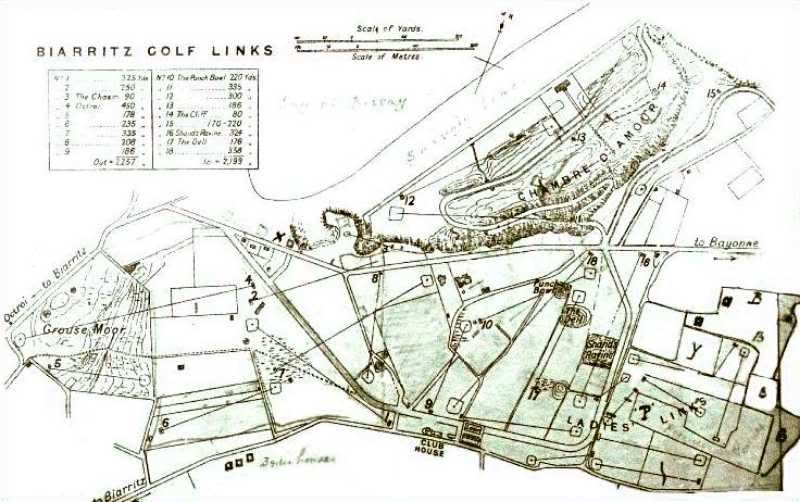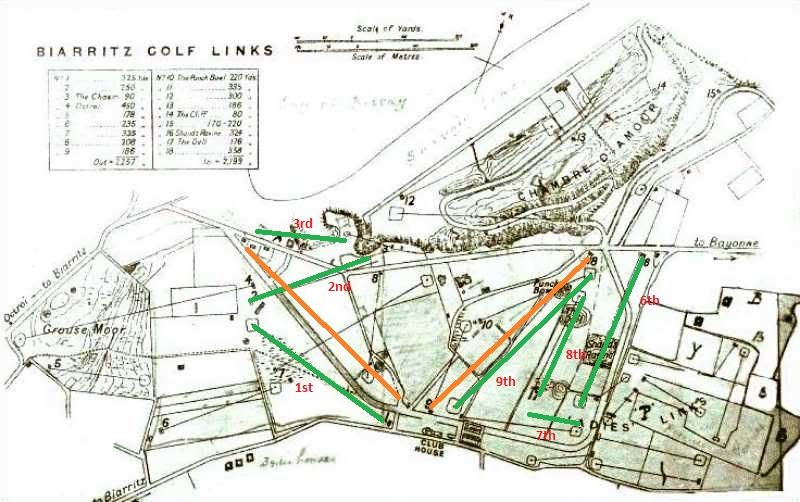While examining the early 18 hole routing map, note that some of the holes are named in the box in the top left. Below I've tried to match the information from the map with the descriptions contained in the 1890 letter to the editor from the club secretary describing the original 9 hole layout.

Letter - 1st Hole - The "Pigeon Hole" - 300 yards -
A fair drive brings you to the edge of some rough, broken ground, covered with clumps of sedge grass. 160 yards from the tee; a cleek, or brassy shot will easily carry the rough ground, which is about 80 yards in extent, and a short iron shot will be probably wanted to reach the green.Map - 1st Hole - 325 yards
Probably close to the same hole.
Letter - 2nd Hole - The "Sea Hole" - 260 yards -
A good drive will get you on towards the corner of the road, which is 200 yards from the tee; from here a full iron shot will reach the green. A careful approach is wanted here, as the hole is on a strip of turf, 30 yards wide, between the road and the edge of the cliff; a ball pulled round to the left will go over the cliff into the Bay of Biscay, a ball sent to much to the right will drop out of bounds into some cultivated land, which entails loss of stroke and distance, while too gay a shot in the right direction will land you in some whins beyond the hole.Map - 2nd Hole - 250 yards
Probably close to the same hole.
Letter - 3rd Hole - The "Chasm Hole"
Map - 3rd Hole - The Chasm - 90 yards
The letter notes this hole was around 200 yards (80 yard carry plus 120 yards to the green). As we've established, we're talking about two different versions of the Chasm Hole.
Letter - 4th Hole - The "Long Hole" - 480 yards - -
Ten yards in front of the tee is a large and “hairy” hedge, then comes a skittle ground and then a corner of a cultivated field, which is out of bounds, so a topped or foozled ball entails the loss of stroke and distance. But 60 yards clears all these impediments, and after the teed shot there are no formidable hazards to be encountered, only a disused road with a small ditch on each side, which runs parallel with the line to the hole for some distance.Map - 4th Hole - Octroi - 450 yards
This one is a bit confusing. The hole on the Map runs to the left towards the Grouse Moor. But from the description of the 5th Hole in the Letter, it would seem that the 4th would have run towards the area of the course containing the Punch Bowl (as marked on the Map), or to the right. The "cultivated field" discussed in the letter could be the same area described in the write up of the 2nd hole.
Letter - 5th Hole - The "Punch-bowl Hole" - 400 yards -
Any drive over 120 yards will clear a bank and narrow land, which crosses the line to the hole; a good brassy shot will then bring you somewhere near the Punchbowl, a deep circular pit, with nearly perpendicular sides and about thirty yards in diameter. This hazard is in the direct line to the hole, and some 300 yards from the tee, and 80 yards in front of the hole. Map - 10th Hole - The Punch Bowl - 270 yards
With the changes in yardage, it appears that this hole was either realigned, with a new green, or was drastically shortened.
Letter - 6th Hole - "Shand's" - 320 yards -
A fair drive of 160 yards brings you to the edge of “Shand’s Ravine,” ... a cleek or brassy shot will take you over, but the lies are not bad if you get in, and a short approach shot will lay you on the green.Map - 16th Hole - Shand's Ravine - 324 yards
Appears to be the same hole with no real changes. The description in the letter closely matches what we see on the Map.
Letter - 7th Hole - The "Hole Across" - 115 yards
This hole does not appear on the map, and may have been consumed into the Ladies Course.
Letter - 8th Hole - The "Dell Hole" - 160 yards -
This hole is also a short one, being about 160 yards, ... and in front of the hole is a deepish dell about forty yards across, but which is easy to play out of if you drop in, as many do.Map - 17th Hole - The Dell - 176 yards
Like "Shand's" the Dell appears to have survived the initial changes in much the same form.
Letter 9th Hole - The "Home Hole" - 360 yards -
This wants an accurately directed teed shot, as there is the Punchbowl on the right, and the Dell on the left, both about 130 yards from the tee; but having avoided these hazards, you have good lying ground for 200 yards, then a narrow lane, with deep banks to cross, and 80 yards to the hole.I'd surmise that the routing of the original course was as follows:
1st Hole - Probably played along the same corridor as the 1st on the map.
2nd Hole - Probably played along the same corridor as the 2nd on the map.
3rd Hole - Along the cliff edge near the location of the 2nd green on the map.
4th Hole - From somewhere close to where we believe the 3rd green lay (near the X on the map) to a location near where the 5th tee would have been.
5th Hole - Played over the Punch Bowl, suggesting it ran on a similar line to the 10th hole on the map but longer.
6th Hole - The same as 16 on the map.
7th Hole - A short hole of 115 yards that played from near the 16th green to close to the 17th tee on the map.
8th Hole - The same as 17 on the map
9th Hole - Close to the same as 18 on the map, playing between the Punchbowl on the right and the Dell on the left.
Here's the map with the original 9 hole routing marked, with one possible solution for how 4 and 5 worked (each marked in orange). For the perfectionists in the group, this is only meant to be a rough attempt at identifying the routing.
